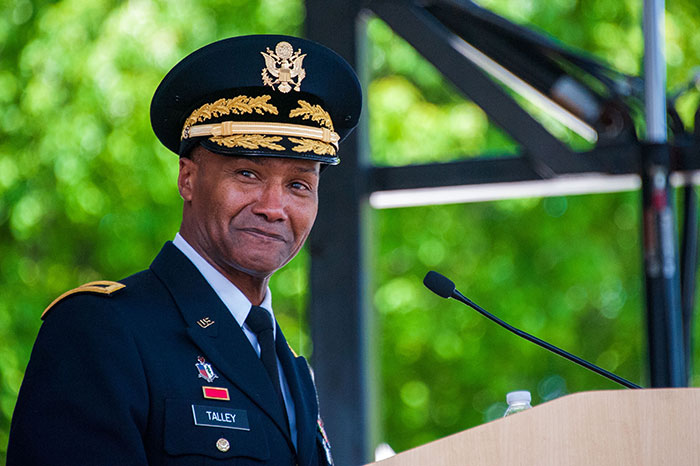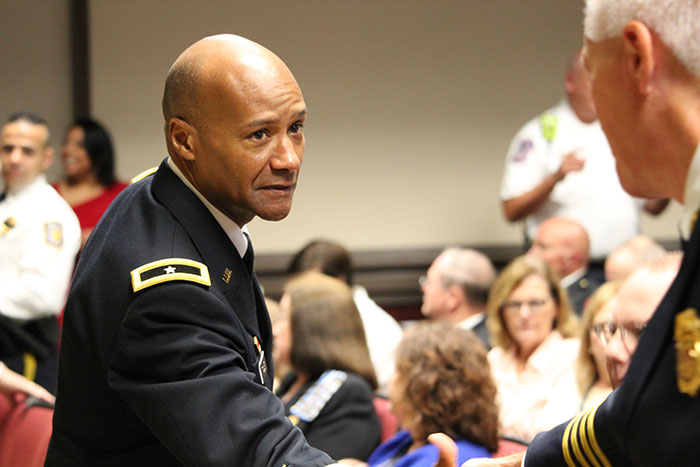Talley, Eager for Next Challenge, Thanks USAMRDC 'Dream Team'

Sitting at the head of the table in the conference room just outside his office, Brig. Gen. Michael Talley reflects on his two-year assignment as Commanding General of both the U.S. Army Medical Research and Development Command and Fort Detrick with the same brand of outsized optimism which has become, in many ways, his trademark of sorts. Not only has his stint at USAMRDC allowed him to take another step in growing and defining his own leadership skills, but it has also proven to be yet another example – only the latest example, of course – of the power and impact of military medicine.
"If you don't pace yourself," he says with a grin, "you'll be out of breath during the first week doing this stuff."
While that comment is certainly meant to apply to the entire term at USAMRDC, it could just as fairly be applied almost exclusively to the Command's efforts in fighting the novel coronavirus pandemic over the past 15 months – a massive mobilization that, while remaining only a small part of USAMRDC's overall efforts, has likely come to define Talley's time at the top of the Command. Specifically, it is his overarching desire to apply a type of simple, effective order to almost all challenges in his path that has become a key component – if not the defining component – of his leadership style.
Says Talley, "Grasping and gaining an understanding of what challenges there were, what problems there were right up front and then being able to organize in a way that addressed the problems – or attack the problems, if you will – was probably the best way to manage everything that had to be done."

Indeed, Talley admits that upon assuming control of USAMRDC in the spring of 2019, his first order of business was to address key infrastructure issues such as facilities maintenance and challenges with regulatory compliance. His response was to – in his own words – "make life predictable" for the Command; an effort that involved developing a campaign plan, installing clear lines of effort, then using effective communication to accomplish key goals. That may sound simple enough, but that early commitment to efficiency truly paid off when the novel coronavirus pandemic blossomed globally in the early spring of 2020 – a development which, in turn, saw USAMRDC thrust near the front of the U.S. military's response as requested by the federal government. Once the demand for mobilization came down – mobilization across all levels of USAMRDC, no less – the Command's people, facilities and capabilities were in large part already up-to-speed.
"Any time you can lay out a predictable plan – as much as you can, you don't know everything – that's what I think allowed us a semblance of balance," says Talley. "I'm an old Soldier, I've been downrange in combat operations [before] – so it's really the same approach – it's taking the sum total of your experiences and applying them to a different kind of adversary."
The application of that philosophy yielded a substantial amount of success both for the Command and on behalf of the national pandemic response. In short order, the team at USAMRDC'S U.S. Army Medical Research Institute of Infectious Diseases developed the first animal model testing efforts for COVID-19 products while also – later – establishing a cutting-edge bio-surveillance program. Further, the early days of the pandemic saw USAMRDC's U.S. Army Medical Materiel Development Activity – through their Warfighter Deployed Medical Systems team – facilitate delivery of key materials to ensure deploying units had the equipment required to combat COVID-19. Months later, USAMRDC's Walter Reed Army Institute of Research would begin testing their own vaccine platform. Even now, contributions from all corners of the Command continue in the name of COVID-19 research.
And yet pandemic response served as only a fraction of the overall work performed by USAMRDC over the past year-plus – and indeed, over the course of Talley's tenure. Among the many notable achievements during Talley's time at USAMRDC include: federal approval of the first preventive vaccine for the Ebola virus; the launch of the National Emergency Telecritical Care Network; the establishment of a next-generation human performance lab at USAMRDC's Telemedicine and Advanced Technology Research Center; the brokering of an international partnership to improve Warfighter brain health, and a substantial investment in virtual reality systems designed to improve medical training.
"He was definitely the right leader at the right time to take over MRDC," says Command Sergeant Major Timothy Sprunger of the U.S. Army Regional Health Command Central, a friend who previously served alongside Talley in the same position at USAMRDC. "It speaks to his leadership and his vision that he was able to see through and identify a clear way ahead and get the team all routed in one direction."
If anyone knows Talley well it most assuredly Sprunger, as both additionally served together years ago at the U.S. Army Forces Command and indeed remain close to this day. As such, he provides a unique, more off-the-clock perspective of the outgoing general. For instance, says Sprunger, in their spare time, both men engage in a friendly barbeque competition, with each cooking a chosen cut of meat and then – when possible – sharing with the other for the sake of bragging rights. It is the kind of good-natured rivalry that will no doubt continue as Talley makes the transition to his next assignment as Deputy Commanding General (Operations) of the U.S. Army Medical Command, in Falls Church, Virginia.
"I have been lucky to be one of his trusted agents and witnessed a confident professional who truly cares about the success of his people and the Army mission," says current USAMRDC Command Sergeant Major Victor Laragione about his time with Talley. "I know I will miss his leadership, our battlefield circulation, finding opportunities to recognize our great people and our mentorship sessions. He always provided [a] clear vision and allowed leaders to operate with a wide lane while providing honest feedback in an affable way."
Those remarks about the 'wide lane' Talley offers staffers and subordinates is perhaps – when it's all said-and-done – the most integral part of his leadership strategy; allowing the people who work for the Command – the true experts in their given field – the latitude required to make key decisions and proceed at a pace that makes the most sense for a given objective at any given time. Likening USAMRDC staff to "racehorses, chomping at the bit" to tackle their daily objectives – both inside and outside of a pandemic – Talley marvels even now, at the end of his time at USAMRDC, at the Command's collective energy and passion. It is a passion that – in so many ways – mirrors his own patented approach.
"I just couldn't have asked for a better team," says Talley in a parting statement of praise to the Command's Soldiers, employees and staffers at all levels. "I can't thank them enough for their professionalism, their work ethic, their commitment to everything they do. They all recognize their purpose for what they do is far greater than each and every one of us. Their willingness to get the job done at all costs was – and is – nothing short of spectacular."














